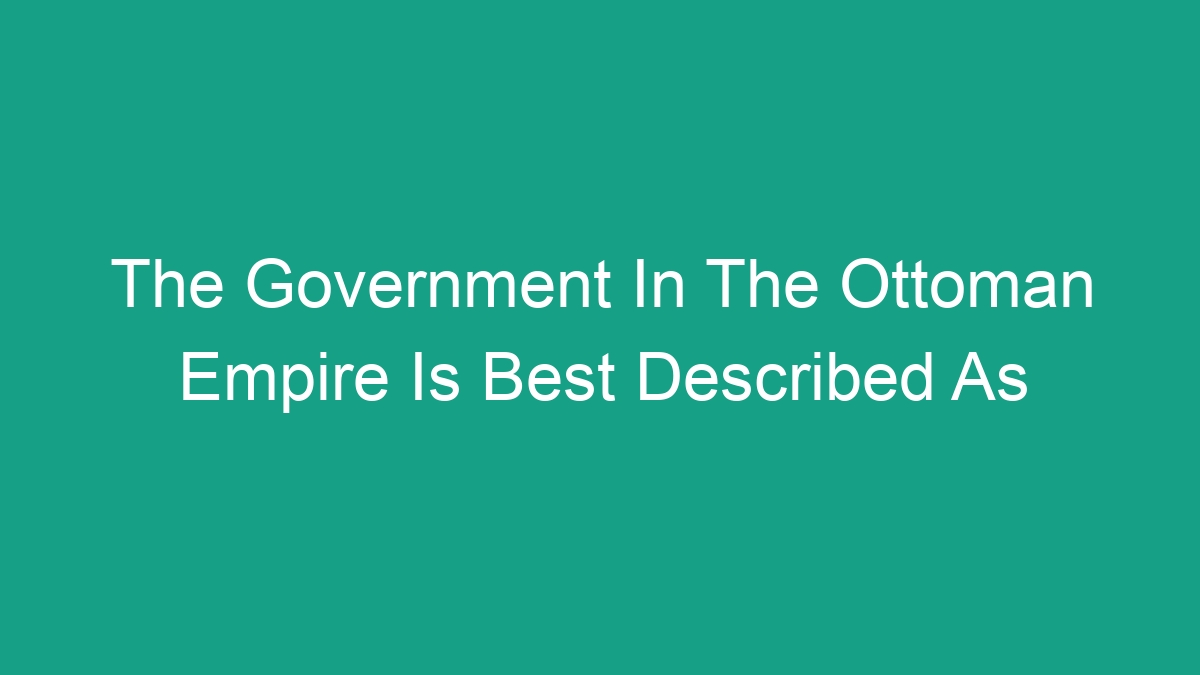
The Ottoman Empire, which spanned across three continents and lasted for over 600 years, had a complex and unique form of government. To best describe the government in the Ottoman Empire, it can be understood as a combination of various elements including a strong centralized authority, a hierarchical administrative system, and a unique system of governance that blended Islamic law with traditional Turkish practices. Let’s delve into the details of how the government in the Ottoman Empire can best be described.
The Structure of Government
The Sultan:
– At the top of the political and administrative hierarchy was the Sultan, who held absolute power.
– The Sultan was seen as the head of the government, the military, and the ultimate religious authority.
– He was typically advised by a council of viziers and other high-ranking officials.
The Imperial Council:
– The Imperial Council, also known as the Divan, was the main advisory body to the Sultan.
– It was made up of the Grand Vizier, who was the chief minister, and various other viziers, as well as military and financial officials.
– The council was responsible for making decisions on matters of state and acted as the highest court of appeal.
The Administrative Structure:
– The empire was divided into provinces, each governed by a governor, or beylerbey, who was appointed by the Sultan.
– Below the governors were other officials responsible for maintaining law and order, collecting taxes, and overseeing local administration.
The Legal System
Islamic Law:
– The Ottoman legal system was based on Islamic law, or Sharia, which was applied to personal and family matters.
– The qadis, or Islamic judges, were responsible for interpreting and applying Sharia law in the courts.
Imperial Decrees:
– In addition to Islamic law, the Sultan issued imperial decrees known as kanun, which governed matters such as taxation, trade, and criminal law.
– These decrees were enforced by a separate administrative apparatus and were an important source of law in the empire.
The Military
The Janissaries:
– The Ottoman military was a powerful institution with the Janissaries serving as the elite infantry of the empire.
– The Janissaries were highly trained and loyal to the Sultan, but they also held considerable influence politically and economically.
The Devshirme System:
– The Ottoman Empire also had a unique system of conscription called the devshirme, which involved the recruitment of Christian boys from the empire’s subject populations to be trained as soldiers or administrators.
– This system ensured a steady supply of loyal and capable individuals for the military and the government.
Government and Society
Millet System:
– The Ottoman Empire was known for its religious and cultural diversity, and it maintained social order through the millet system.
– Under this system, different religious communities, such as Christians, Jews, and Muslims, were allowed to govern their own affairs according to their own religious laws and traditions.
Taxation and Trade:
– The government in the Ottoman Empire relied on taxation as a major source of revenue, and it had a sophisticated system for collecting taxes from its subjects.
– Trade also played a significant role in the empire’s economy, and the government regulated commerce through networks of guilds and trade routes.
Key Characteristics of the Government
Centralization:
– One of the key characteristics of the government in the Ottoman Empire was its strong centralized authority under the Sultan.
– The Sultan had the ultimate decision-making power and was able to exercise control over vast territories and diverse populations.
Religious Influence:
– Islamic law and the role of the Sultan as the Caliph gave religious legitimacy to the government in the Ottoman Empire.
– Islamic principles and practices were integrated into the legal and administrative systems, and the government was closely tied to religious institutions.
Mixture of Institutions:
– The Ottoman government was a unique blend of Islamic, Turkish, and bureaucratic institutions.
– This mixture of traditional Islamic governance, Turkish tribal practices, and centralized bureaucracy created a distinct form of government in the empire.
Conclusion
In conclusion, the government in the Ottoman Empire can be best described as a combination of centralized authority, a hierarchical administrative system, and a unique blend of Islamic and traditional Turkish practices. The Sultan held absolute power and was advised by the Imperial Council, while the legal system was based on a combination of Islamic law and imperial decrees. The military and the relationship between the government and society were also significant aspects of the Ottoman government. This complex and multi-faceted system of governance contributed to the longevity and influence of the Ottoman Empire throughout history.




